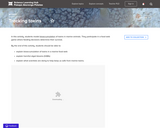
Students model bioaccumulation of toxins in marine animals. They participate in a food web game where feeding decisions determine their survival.
- Subject:
- Science
- Material Type:
- Activity/Lab
- Provider:
- Science Learning Hub
- Date Added:
- 03/07/2018

Students model bioaccumulation of toxins in marine animals. They participate in a food web game where feeding decisions determine their survival.

Students will examine water samples collected at various depths and note any organisms found. Then, they will brainstorm and list plants and animals that might be found in a river ecosystem and discuss the ways that these organisms might interact with each other.

In this lesson, students will analyze population graphs, collect data to generate their own population graph, and experience limiting factors and their impact on carrying capacity in a small deer population. Students will be able to identify, explain, and evaluate the impact that different limiting factors have on the population of organisms including food, water, shelter, predation, human interference, changes in birth and death rate, changes in immigration and emigration, disease, and reproduction.

In this lesson, students combine their knowledge with information from dictionaries to define "urban forest" and “ecosystem.” They relate their school to an ecosystem and then create a web diagram to show the connections that parts of urban forests have. They extend that idea to the connections urban forests have to other ecosystems using the water cycle as an example. To conclude, students write a few paragraphs to describe and compare urban forest ecosystems and rural forest ecosystems.

In this lesson, students will analyze real scientific data from a short visualization clip to form logical hypotheses about what drives the migration patterns of raptors. Students will also describe and explain the connectedness of organisms within and across ecosystems and illustrate how primary productivity is the foundation of all food webs and how seasonal changes in primary productivity influence the behaviors of higher order consumers.
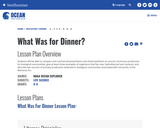
Students will describe at least three energy-obtaining strategies used by organisms in deep-sea reef communities. They will also interpret analyses of oxygen isotope values to connect these energy-obtaining strategies with the organisms found in the communities.

In this project, students identify an invasive species and its impact on local ecosystems by doing research and performing a quadrant study. Once students have assessed the health of their local ecosystem, they will work with environmentalists to devise a plan that will alleviate the invasive species problem in their area.
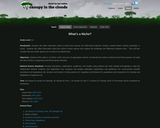
Students will collect information about a cloud forest species: the white-faced capuchin monkey, mantled howler monkey, bromeliad, or orchid. Students will collect information about the niches of these species then analyze the similarities and differences between them. They will then consider how two similar species can co-exist in a localized area.
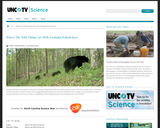
This multimedia resource, part of the NC Science Now series, describes how Dr. Roland Keys, Director of the Biodiversity and Earth Observation Lab at the NC Museum of Natural Science, is using remote controlled, hidden cameras, telemetry and GPS to record animal behavior and movement and to study whether human activity is affecting animal populations in a specific area. Components of this resource include a video, a related blog article, and an interview with Dr. Keys. Links to these components are provided on the page under the heading "UNC-TV Media."

In this collection of five inquiry-based, hands-on lesson plans, students explore white-tailed deer biology and forest ecology. Each lesson builds upon the previous one, culminating in a final assignment for the students. These lessons focus on the impact of deer on the forest ecosystem and the need for better education and understanding about the issues surrounding deer abundance.
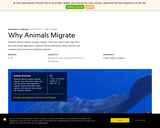
Students discuss reasons animals migrate. Then they watch video clips from the series Great Migrations, organize factual information about species, and compare and contrast two migratory species,

In this lesson, students will identify and illustrate the four main stages of forest succession: grass and forbs, shrubs and saplings, pole timber, and mature timber. After conducting research, students will list the natural habitat and preferred food of a given wildlife species.

In this lesson, students will comprehend that populations of organisms are affected by elements of their environment. Students will observe that populations of animals do not stay at the same number year after year. Students will understand the importance of suitable habitat and how various factors may affect wildlife populations.

In this activity, students will simulate a wolf and its habitat and observe what happens when the limiting factors change over time.

In this simulation activity, some students will become wolves and the other students will be the prey of the wolf. The goal of the simluation is to have the wolves work together to survive.

This is an encyclopedia entry for the term "ecosystem." An ecosystem is a geographic area where plants, animals, and other organisms, as well as weather and landscape, work together to form a bubble of life. Text for this entry is appropriate for the middle and high school grade levels.

This encyclopedia entry is for the term "food chain." A food chain describes who eats whom in the wild. Text for this entry is appropriate for the upper elementary, middle and high school grade levels.

This is an encyclopedia entry for "habitat." A habitat is a place where an organism makes its home. Text for this entry is appropriate for middle and high school levels.

This is an encyclopedia entry for "keystone species," a plant or animal that plays a unique and crucial role in the way an ecosystem functions. Text for this entry is appropriate for the middle and high school grade levels.

This encyclopedia entry is for the term "tide." The regular rise and fall of the ocean?s waters are known as tides. Along coasts, the water slowly rises up over the shore and then slowly falls back again. Text for this entry is appropriate for the middle and high school grade levels.